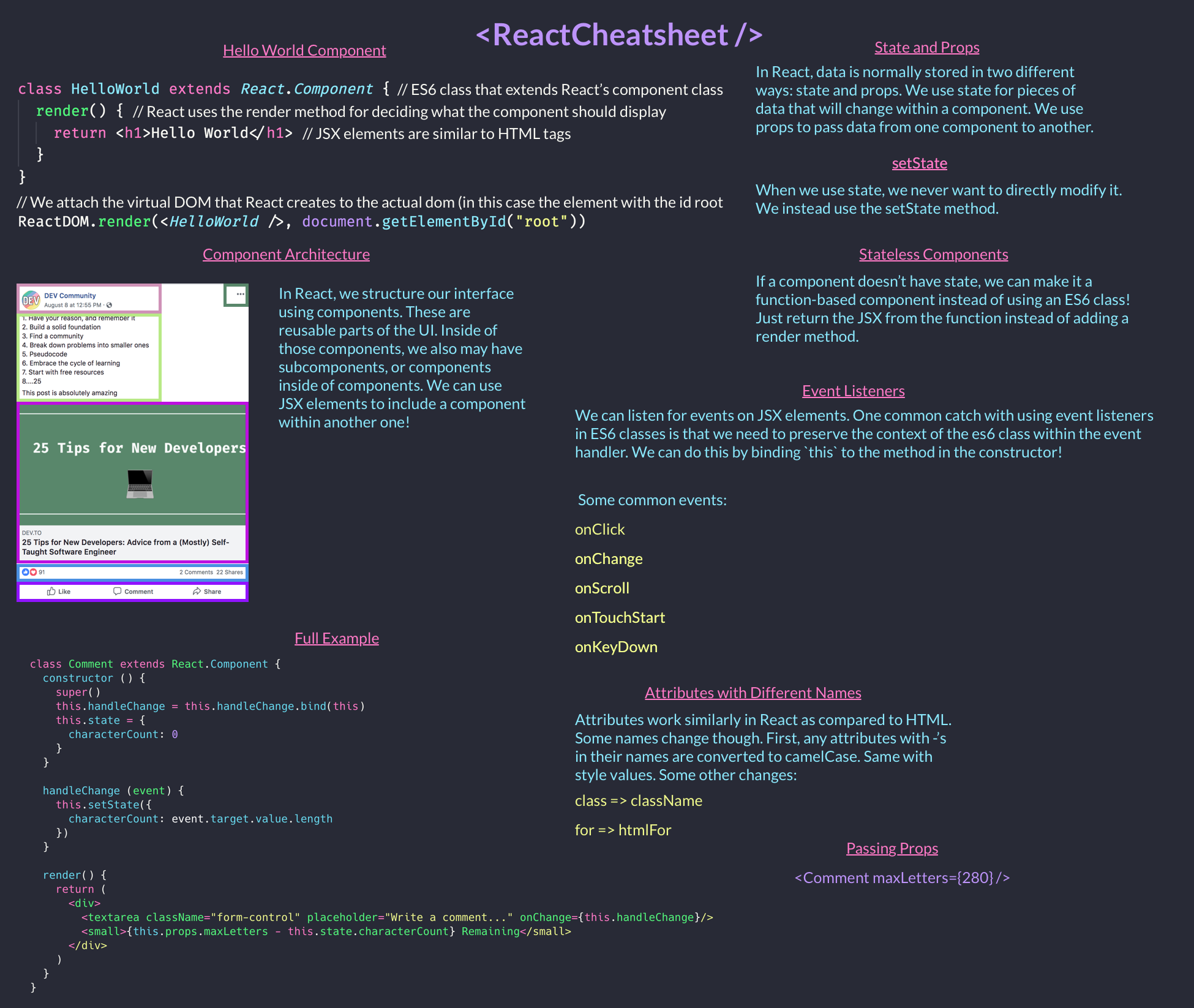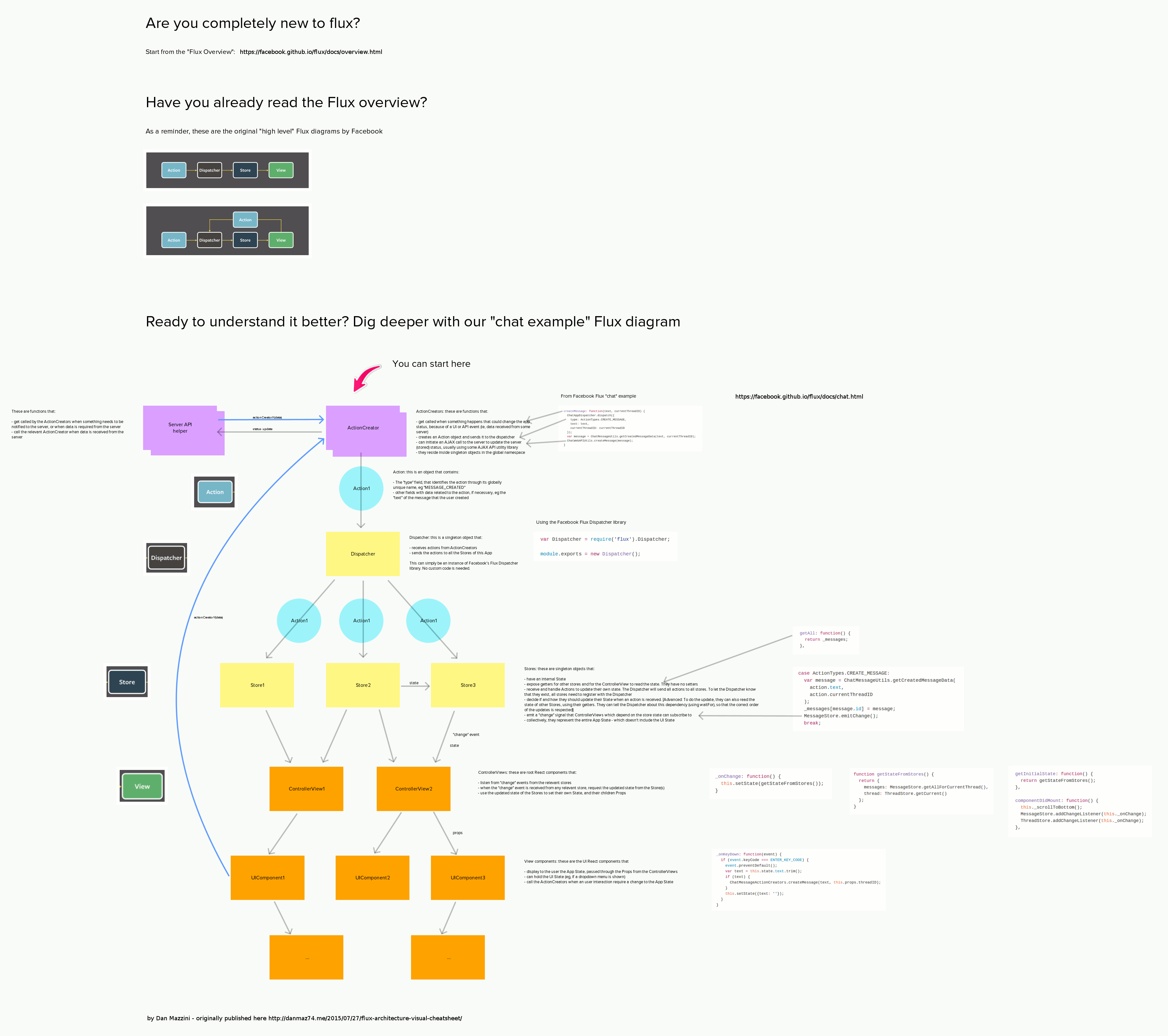I just finished watching this excellent video series on Egghead. I found that it really simplified a lot of the hard parts of useEffect and also explained a few of the other hooks that I haven't taken the time to learn yet. I was so impressed by it that I was inspired to write down an even shorter version for later reference to help reinforce the lessons, and also to share with you. If any of this feels like there's not enough detail for you, I would highly encourage you to check out the videos on egghead, where Ryan goes into more detail and gives examples for each.
useState
Check our best react cheat sheet. You can follow this easy to use reactjs cheat sheet and create your project faster using it. React is an open. React Cheat Sheet React Podcast React Podcast landing page. For more advanced React users, who just want to relax while still learning something new, the React Podcast might be a way to go. While not a learning resource pre-se, the podcast can help you get a better grasp of the React and overall web dev ecosystem, as well as an overview of. Results in dangerous XSS vulnerabilities. This cheat sheet gives an overview of secure coding guidelines for React. Avoiding XSS in React applications Version 2020.002 Security Cheat Sheet Simple data binding By default, React prevents data to be seen as code. The default data binding mechanism does not cause HTML injection attacks. React JS is a JavaScript library being used for building user interfaces, primarily for single React JS Cheat Sheet; Beginner's Guide to Learn React It was first deployed on Facebook’s newsfeed in 2011 and on Instagram.com in 2012. To help you remember all the details I ceated a one-page React Testing Library cheat sheet with all the tips (+ more) and a list of resources that you can get at the end of this post. Before we have a look at the application let's start with a broader look at testing React apps in general.
I'm not going to cover useState because that's out of scope for what I want to accomplish here, but it is a pre-requisite for understanding what's below. If that one doesn't make sense to you already, you won't understand the rest of these.
useEffect
useEffect has three different usage modes, and is used to synchronize React with anything that React doesn't control; from the page title to making AJAX requests or dealing with device api's (like getUserMedia).
- No 2nd argument: Executes on every render.
- Array of variables as 2nd argument: Executes any time any of those variables change.
- Empty array as 2nd argument: Executes only on FIRST render, and never again until page refresh.
React Testing Library Cheat Sheet
In this case, I'm attaching an event listener to the window's resize event, and if I re-run that every time the component re-renders, I'll be attaching a new listener every time, effectively calling my listener potentially hundreds or thousands of times every time the event occurs.
If your effect creates something that needs to be cleaned up when the component is removed (like removing created event listeners), the effect should return a function that does that cleanup work, and React will run it only when the cleanup is needed. Since that's exactly what I did in the last code block above, let's fix it to be correct here:
useRef
Not just for persisting a reference to an input element!
useRef can be treated similarly to useState Among us unity crash fix. , except that it doesn't trigger a re-render. If your render function displays the ref value, the rendered content won't be updated when the ref is updated, but if something triggers a re-render then the latest value from the ref is available to the render function. You can use this to track data changes in a more performant way, as long as you don't need those changes to be re-rendered.
useMemo
Memoization is caching the results of a pure function, which can be helpful if that function requires intensive or long-running calculations. While implementing memoization is a simple and well understood pattern, useMemo combines that with the API of useEffect so that it only ever runs if the input values change.
useCallback
Whereas useMemo returns a memoized value, useCallback returns a memoized function. When you want to be able to pass the memoized callback function around as a property, use useCallback instead. Via closure this helps you expose functionality without exposing internal state.
useLayoutEffect
useLayoutEffect is different from useEffect in that it runs before the DOM paints. This allows you to make changes that will affect what your app looks like (positioning elements, for example), without causing the screen to flash with a repaint because you moved something immediately after it was painted.
useContext

Contexts have been around for a while now as a useful way to work around prop drilling. useContext makes it simple to create and access contexts wherever you need them.

Creating and applying the provider:
Using properties of the context elsewhere:
useReducer
This one is like a mashup of useState and Redux. You dispatch actions that are all handled by a single (composable if you want) reducer, to update a state object containing multiple values. Generally considered a best practice not to group values that aren't related. For example, groupe the state for inputs in a form.
useDebugValue
Lastly, useDebugValue allows you to highlight something in the React Dev Toolsfrom inside a custom hook. Think of it like console.log but better. When your debug value is large or complex, you can improve app performance by passing a 2nd argument to useDebugValue. The 2nd argument is a function and is used to format the value. This can be a performance benefit because the format function is only called if the value is inspected in the dev tools.
This shows up in the devtools as a key-value pair, and the key name is the name of your custom hook.
Wrapping Up
React Js Cheat Sheet Pdf

As I mentioned at the top, this was a heavily summarized version of what I learned from Ryan Harris' egghead course, React Hooks: Revisited. Thanks to Ryan for a fantastic quick video course and his simple and clear explanations!
